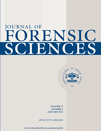Usefulness of Forensic Dental Symbols© and Dental Encoder© Database in Forensic Odontology*
Presented at the 21st Meeting of the INTERPOL Standing Committee on Disaster Victim Identification, Lyon, France, May 18–20, 2010.
Abstract
Abstract: A new universal graphic dental system, Forensic Dental Symbols©, has been created to provide precision in the construction of dental records, improve standardization, and increase efficiency in dental identification procedures. Two hundred and thirty-four different graphic symbols representing the most frequent clinical status for each tooth were designed. Symbols can be then converted to a typographic font and then are ready to use in any computer. For the appropriate use, manipulation, and storage of dental information generated by the Forensic Dental Symbols©, Dental Encoder© database has been created. The database contains all the information required by INTERPOL Disaster Victim Identification (DVI)-dental-forms. To explore the possibilities that Dental Encoder© offers, an antemortem dental database from a Spanish population of 3920 military personnel had been constructed. Data generated by Dental Encoder© were classified into sex and age groups. The program can perform an automatic search of the database for cases that match a selected clinical status presented in a single tooth or a combination of situations for several teeth. Moreover, Dental Encoder© allows information to be printed on INTERPOL DVI-dental-forms, or the inclusion of any completed form into any document, technical report, or identification of dental report.




